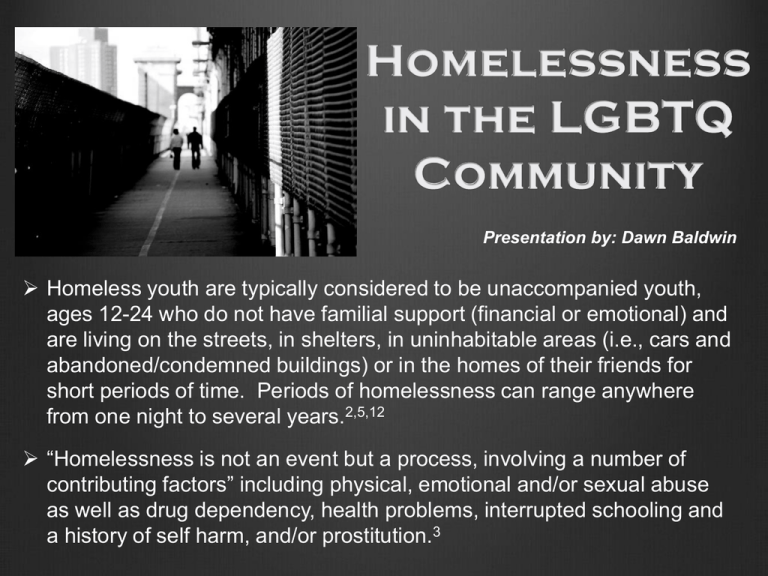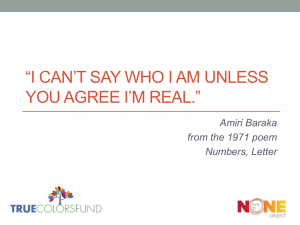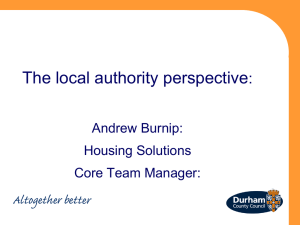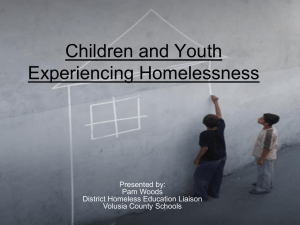
Presentation by: Dawn Baldwin
Homeless youth are typically considered to be unaccompanied youth,
ages 12-24 who do not have familial support (financial or emotional) and
are living on the streets, in shelters, in uninhabitable areas (i.e., cars and
abandoned/condemned buildings) or in the homes of their friends for
short periods of time. Periods of homelessness can range anywhere
from one night to several years.2,5,12
“Homelessness is not an event but a process, involving a number of
contributing factors” including physical, emotional and/or sexual abuse
as well as drug dependency, health problems, interrupted schooling and
a history of self harm, and/or prostitution.3
Lesbian, Gay, Bisexual, Transgendered and Queer/Questioning
(LGBTQ) adolescents have been found to experience higher levels
of victimization than their heterosexual counterparts both before
and after leaving the home.1,10 Additionally, they are at a higher
risk for mental health issues, sexual exploitation, and chemical
dependency.1,5,8
Several studies have speculated that as many as 20% to 40% of
an estimated 1.6 million homeless youth in the United States
identify themselves as LGBTQ.1,4,5,6,8,10,12
Of the estimated 20% to 40% of LGBTQ Homeless Youth in the
U.S., it is estimated that anywhere from 25% to 50% of these youth
are asked to leave and even forcibly removed from their homes
due to their sexual orientation and/or gender identity.5,6,7,8,12
Estimated 1.6 Million Homeless Youth in
the U.S.
Non-LGBTQ Homeless
Youth
Estimated 20% - 40%
LGBTQ Homeless Youth
HOW DO LGBTQ YOUTH BECOME HOMELESS?
Many leave home willingly due to family rejection and increased antigay mistreatment at home, school, and in their communities due to their
self-identification as LGBTQ.2,9
Many LGBTQ adolescents leave home due to incidents of
parental/caretaker physical abuse, sexual abuse and neglect as well as
their caretaker’s abuse of drugs and/or alcohol and possible
incarceration.2,7,12
Approximately 10% more LGB youth
(transgendered and queer/questioning
individuals were not included in this
particular study) than non-LGB youth
reported having been in the custody of
social services at least once,
demonstrating a troubled home life.10,11
Most LGBTQ adolescents, however,
likely leave because they believe they
will be better off on their own.
Survival Strategies of LGBTQ Homeless Youth
Survival strategies of many homeless LGBTQ youth include4,12:
Accessing homeless services (i.e., shelters and food pantries)
Asking friends or family for money
Making, dealing, and/or running drugs
Joining gangs
Panhandling
Robbery and theft
Prostitution (Survival sex)
Working
POSSIBLE EFFECTS THESE SURVIVAL
STRATEGIES MAY HAVE ON THE YOUTH4,8,10
Decreases in self-esteem/self-worth
Increased risk of Sexually Transmitted Infections, including HIV
Higher levels of hopelessness, depressive symptoms and anxiety
Increases in drug and alcohol use and suicidality
Increased risk of police interaction and
incarceration
Greater risk of psychological disorders
Increases in aggression and physical
violence
Higher risk for victimization
Higher hospital admission rates and an
increased risk of death
WHY DO LGBTQ YOUTH REMAIN HOMELESS?
Based on their previous
experiences with authority figures,
LGTBTQ youth may have a fear of
continued victimization by adults if
they seek help to end their
homelessness. Additionally, they
may fear victimization from others
on the street if they are found to
have sought help.4,12
They are more adversely affected by the negative social relationships and
low support levels they acquire on the street than their non-LGBTQ
counterparts. They may also refuse outside services as a defense
mechanism to reduce exposure to trauma by others.8,12
Homeless youth services are not always tailored to the population they
wish to help. It is more likely that a youth will seek assistance if they know
that those services will be sensitive to their specific needs as a LGBTQ
youth.1,4,12
HOW YOU CAN HELP
REACH OUT!
Donate money,
food and supplies to a local shelter,
food pantry or organization that
provides for LGBTQ youth and
families.
GET INVOLVED!
Volunteer
your time or services to a local
LGBTQ-friendly organization.
GET THE WORD OUT!
Work at a local organization or convey your
interest in serving as a Board member to become an advocate for the community.
VOTE!
Support LGBTQ and homeless legislation locally and nationally,
including the Reconnecting Youth to Prevent Homelessness Act introduced by
Massachusetts Senator John Kerry this past May 2011.
FIGHT!
Join celebrities in their fight to end LGBTQ homelessness.
Click here for a message from Lady Gaga.
See a message from the Give a Damn campaign here.
NATIONAL RESOURCES FOR LGBT HOMELESS YOUTH
AND THEIR FAMILIES AND FRIENDS
The Ali Forney Center and The Friends Project
The Friends Project was started by David Raleigh to raise money for the Ali Forney
Center in New York City, which provides emergency and transitional housing and
additional resources to the area’s homeless LGBT Youth. Watch The Friends Project
video here.
Larkin Street San Francisco Youth Center
Assists LGBTQ homeless youth in obtaining health services, housing, employment and
education. Watch Larkin Street Stories: The Homeless LGBT Experience here.
National Coalition for the Homeless
National advocacy center working to end homelessness.
National Gay and Lesbian Taskforce
National organization that offers legal and political representation as well as research
and policy analysis for advancement of the LGBTQ community.
Southern Arizona’s Wingspan
Wingspan, based in Tucson, Arizona offers support to the community by providing crisis
intervention and advocacy to homeless LGBT Youth. On a more basic level, they also
provide these youth with food, bus passes, clothing and hygiene supplies. Watch
Wingspan video here.
LOCAL RESOURCES
Howard Brown Health Center’s Broadway Youth Center
Chicago center offers medical and counseling services, youth workshops, food,
showers, hygiene supplies to LGBTQ homeless youth on a drop-in basis.
La Casa Norte
Offers medical testing, employment assistance and educational support to area
homeless teens. La Casa Norte also runs several housing programs in the
Chicago area to cater to homeless youth with different backgrounds.
LGBTQ-identified youth welcome.
NCO Youth and Family Services
Naperville, IL centers offer group and transitional housing as well as counseling and
assistance for area homeless teens. LGBTQ-identified youth welcome.
Teen Living Programs
Offers emergency and transitional housing as well as skill-building groups for area
homeless teens. LGBTQ-identified youth welcome.
UCAN - Uhlich Children’s Advantage Network (Chicago)
Offers counseling and assistance with living arrangements, including a LGBTQ
Home Host Program
References
1.
Cochran, B. N., Steward, A. J., Ginzler, J. A., & Cauce, A. (2002). Challenges faced by homeless sexual minorities:
Comparison of gay, lesbian, bisexual, and transgender homeless adolescents with their heterosexual counterparts. American
Journal of Public Health, 92(5), 773-777.
2. Cull, M., Platzer, H., & Balloch, S. (2006). Out on my own: Understanding the experiences and needs of homeless lesbian,
gay, bisexual and transgender youth. Health and Social Policy Research Centre, University of Brighton.
3. Dunne, G. A., Prendergast, S., & Telford, D. (2002). Young, gay, homeless and invisible: A growing population? Culture
Health & Sexuality, 4(1), 103-115.
4. Hein, L. C. (2011). Survival strategies of male homeless adolescents. Journal of the American Psychiatric Nurses
Association, 20(10), 1-9.
5. National Alliance to End Homelessness (2008), “Incidence and Vulnerability of LGBTQ Homeless Youth,” Youth
Homelessness Series Brief No. 2, downloaded from http://www.endhomelessness.org/content/article/detail/2141/
6. Pergamit and Ernst (2010a). “Runaway Youth’s Knowledge and Access of Services.” Available at
http://www.nrscrisisline.org/media/documents/NORC_Final_Report_4_22_10.pdf
7. Ray, N. (2006). Lesbian, gay, bisexual and transgender youth: An epidemic of homelessness. New York: National Gay and
Lesbian Task Force Policy Institute and the National Coalition for the Homeless.
8. Rosario, M., Schrimshaw, E. W., & Hunter, J. (2011). Homelessness among lesbian, gay, and bisexual youth: Implications for
subsequent internalizing and externalizing symptoms. Journal of Youth and Adolescence, online only.
doi:10.1007/s10964-011-9681-3
9. Ryan, C., Huebner, D., Diaz, R. M., & Sanchez, J. (2009). Family rejection as a predictor of negative health outcomes in
white and latino lesbian, gay, and bisexual young adults. Pediatrics, 123(1), 346-352.
10. Van Leeuwen, J. M., Boyle, S., Salomonsen-Sautel, S., Baker, D. N., Garcia, J. T., Hoffman A., & Hopfer, C. J. (2006).
Lesbian, gay, and bisexual homeless youth: An eight-city public health perspective. Child Welfare, 85, 151-170.
11. Walls, N. E., Potter, C., & Van Leeuwen, J. (2009). Where risks and protective factors operate differently: Homeless sexual
minority youth and suicide attempts. Child and Adolescent Social Work Journal, 26(3), 235-257.
12. Whitbeck, L. B., Chen, X., Hoyt, D. R., Tyler, K., & Johnson, K. D. (2004). Mental disorder, subsistence strategies, and
victimization among gay, lesbian, and bisexual homeless and runaway adolescents. Journal of Sex Research, 41(4), 329342.
*All photos courtesy of Brett Sandusky
**Please feel free to utilize this presentation as a private teaching tool, however, this presentation may not be copied in whole or in
part without the written consent of the author. Contact Dawn Baldwin for use of presentation or photo materials at
dawn_baldwin@hotmail.com. Thank you for your cooperation.









